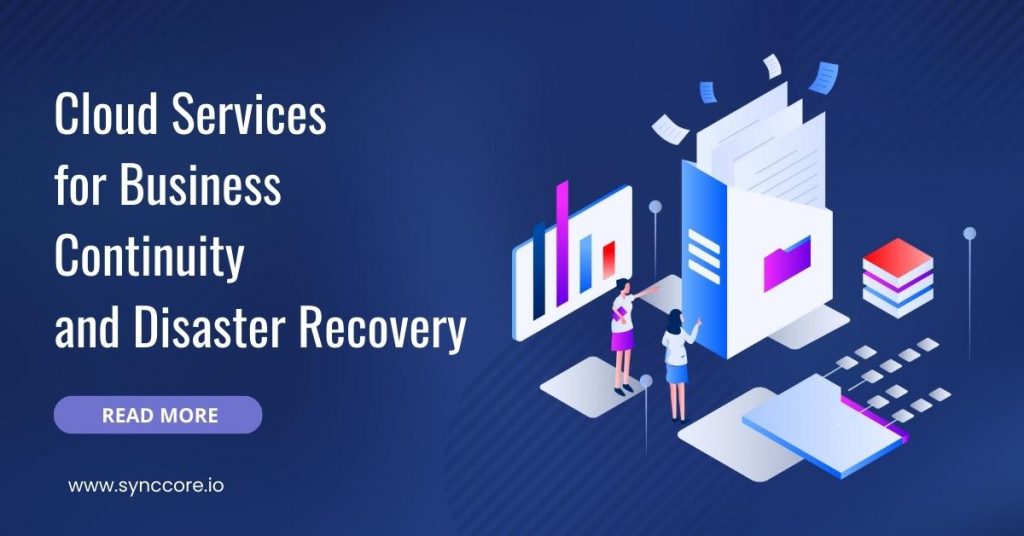Cloud Services for Business Continuity and Disaster Recovery: Develop a business continuity and disaster recovery plan backed by cloud-based services to ensure your company is operational during an emergency.
Unexpected events could threaten your business, cause operations delays, and even cause you to be out of business. Many companies are affected by unforeseen circumstances, like power outages, equipment malfunctions or hackers, malice, and natural catastrophes.
A business continuity plan and a disaster recovery plan are in place to cover your essential IT infrastructure along with your applications and business data that aid in keeping your business operating even under the most extreme situations.
Backup of your data won’t suffice; cloud services will need to provide a cost-effective and reliable source for disaster recovery. Learn how to prepare for the possibility of unexpected events and discover how cloud-based services can fit into your company’s backup and recovery strategies.
Table of Contents
Cloud Services for Business Continuity and Disaster Recovery

What is Business Continuity?
Business continuity refers to the sophisticated plan and preparation a business takes to ensure its operations run smoothly in the face of unplanned events or cybersecurity threats.
BCDR is often interpreted to be a response only to natural disasters. In reality, more than 90 percent of downtime incidents result from human error, including cyber-related incidents. No matter how big and size your business, the consequences of these events can affect your core business tasks, cause substantial financial losses, and harm the reputation of your business.
What is a Business Continuity Plan?
Business continuity plans are a procedure companies use to ensure that their operations run during a crisis. The objective is to ensure your business’s operations continue functioning and remain profitable in an unplanned circumstance. The plan should contain the company’s most essential functions and what people are responsible for carrying it out.
The business continuity plan must be prepared for situations that could cause the operation to cease entirely and any event that could hinder your company from recovering following the incident.
The business continuity plan isn’t exclusively created for large corporations or growing companies. Small companies are more frequently of cyber-attacks since smaller businesses are less likely to possess the resources to safeguard themselves. Therefore, every business should have a disaster recovery plan, no matter how large.
What is Disaster Recovery?
Disaster recovery is a strategy to restore access and functionality of your technology infrastructures, software, and data following an unplanned event. It is a method to respond to such incidents so that organizations can restore their hardware, networks, software, data processes, employees, and other equipment.
What is a Disaster Recovery Plan?
A disaster recovery strategy provides an easy-to-follow approach to recovering damaged IT networks and systems essential to business. The objective is to reduce the loss of data so your company can function again after an incident. The plan for disaster recovery is based on replicating computer processes and data at a different place (either physically or electronically) that is not affected by the disaster; if natural disasters damage the IT infrastructure and you need to recover deleted data and applications at the second site.
Business Continuity Vs. Disaster Recovery
What is the distinction between business continuity and disaster recovery plans?
While these appear to be similar, they provide distinct advantages. Disaster recovery plans allow businesses to restore all critical IT services and business operations following an emergency, such as a computer virus infecting a network or a ransomware attack.
On the other hand, business continuity plans keep the entire business running and functioning after an unexpected event, whereas disaster recovery plans are part of more extensive business continuity plans. Business continuity aims to avoid costly production interruptions, whereas disaster recovery seeks to prevent the loss of critical business data and processes.
Business Continuity and Disaster Recovery Planning Steps
Despite profits, size, or industry, having a business continuity plan and disaster recovery program is critical for your company.
Here are the first steps to start your business continuity plan and disaster recovery program:
Assessment
Begin by examining the critical business functions that impact operations most. Analyze your organization’s processes, determine their importance, and identify potential threats.
Business Recovery
Document the steps and actions needed to recover your most critical data and applications so that users can work remotely and effectively in an emergency.
IT Recovery
This should include recovery plans and actions for the technology required to restore your IT applications, backend systems, and data.
Crisis Management
Outline a specific plan for dealing with a crisis. Determine which internal teams will be in charge of implementing each element and communicate the program to all employees and users so that everyone knows what to do in the event of a disaster.
Business Continuity and Disaster Recovery in Cloud Computing
Cloud-based solutions have emerged as a critical component of business continuity. Because the cloud uses the Internet to store data and applications rather than a physical hard drive, organizations can easily back up and retrieve their most critical data from virtually anywhere. This means less data loss and faster recovery in natural disasters or emergencies.
Here are three cloud solutions you should consider including in your business continuity plan:
Disaster Recovery as a Service (DRaaS):
Continuous data protection in the cloud with Disaster Recovery as a Service secures your data, applications, and virtualized infrastructure. Data hosting servers are updated to keep your most critical applications available even in a disaster. Changes to your data are constantly captured and transferred to your DR server, allowing you to recover to the point before failure.
Infrastructure as a Service (IaaS):
Using Infrastructure as a Service, you can significantly lower capital expenditure expenses while protecting your company from natural disasters and moving your IT infrastructure to the cloud. This solution offers dependable disaster recovery and complies with regulatory standards by acting as a distant target for your duplicated environment.
Being located in data centers with enterprise-level security, including security guards, external systems, biometric systems, security scanners, and constant digital surveillance and recording, gives you the peace of mind that your most important applications are safe.
Backup as a Service (BaaS):
Backup as a Service (BaaS) allows your company to quickly multiple backup copies of critical business data to different media types. This ensures that if your company needs to restore data to an on-premises platform, a current backup is always available. Backup data should also be encrypted at rest and in transit to protect it from viruses and cyberattacks. Organizations should consider data immutability to ensure unauthorized users cannot manually tamper with backup data.
Business Continuity and Disaster Recovery Services
A business continuity plan backed up by cloud-based disaster recovery services could mean the difference between successfully navigating a disaster and folding. Learn more about dependable solutions for dealing with the unexpected.
Read More:



